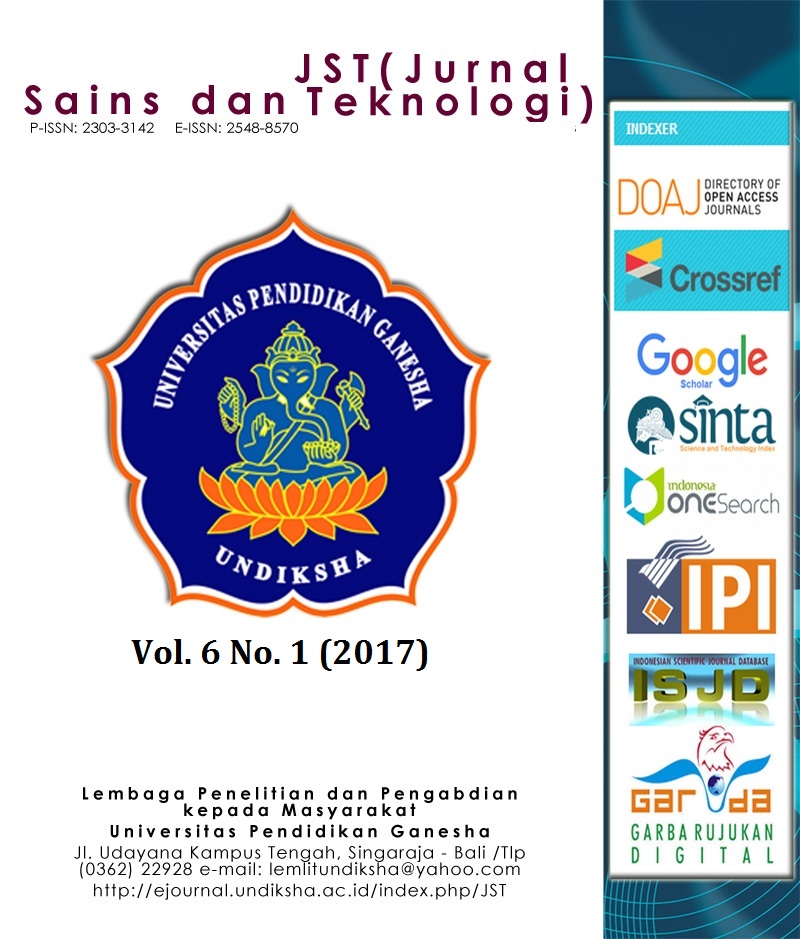PEMODELAN MEKANISME SUMBER GEMPA BUMI RANSIKI 2012 BERKEKUATAN MW 6,7
DOI:
https://doi.org/10.23887/jstundiksha.v6i1.9333Keywords:
mekanisme sumber gempabumi, inversi, isola, HC-plotAbstract
Salah satu gempabumi merusak yang terjadi di Indonesia pada tahun 2012 yaitu gempabumi Ransiki, Papua Barat 21 April 2012, Mw 6,7. Yang menarik dari gempabumi ini yaitu lokasi gempabumi yang berdekatan dengan dua sesar, yaitu sesar Ransiki dan sesar Yapen sehingga tujuan penelitian ini yaitu membuat pemodelan dan menganalisis mekanisme sumber gempabumi untuk mengetahui sesar penyebab gempabumi Ransiki. Mekanisme sumber gempabumi dimodelkan dari proses inversi tensor momen menggunakan program Isola. Untuk menentukan bidang sesar sebenarnya digunakan program HC-plot. Hasil inversi tensor momen menunjukan bahwa gempabumi Ransiki merupakan gempabumi mekanisme sesar geser dengan bidang nodal 1; strike 3550, dip 680, rake -1650 dan bidang nodal 2; strike 2590, dip 760, rake -230. Pengolahan dengan program HC-plot menghasilkan bidang sesar sebenarnya yaitu bidang nodal 2 dengan strike 2590, dip 760, rake -230. Hasil ini menunjukan bahwa gempabumi Ransiki 21 April 2012 Mw 6,7, disebabkan oleh sesar Yapen dengan mekanisme sesar geser mengiri berarah barat-timur.References
Baldwin, S. L., Fitzgerald, P. G., & Webb, L. E. (2012). Tectonics of the New Guinea region. Annual Review of Earth and Planetary Sciences, 40, 495–520.
Bormann, P., Baumbach, M., Bock, G., Grosser, H., Choy, G. L., & Boatwright, J. (2002). Seismic sources and source parameters. IASPEI New Manual of Seismological Observatory Practice, 1, 1–94.
Bouchon, M. (1981). A simple method to calculate Green’s functions for elastic layered media. Bulletin of the Seismological Society of America, 71(4), 959–971.
Carvalho, J., Barros, L. V., & Zahradník, J. (2016). Focal mechanisms and moment magnitudes of micro-earthquakes in central Brazil by waveform inversion with quality assessment and inference of the local stress field. Journal of South American Earth Sciences, 71, 333–343.
Choi, H., & Noh, M. (2010). Source parameters of the May 2, 2009 Andong earthquake in South Korea. Geosciences Journal, 14(3), 269–276.
Coutant, O. (1989). Numerical study of the diffraction of elastic waves by fluid-filled cracks. Journal of Geophysical Research: Solid Earth, 94(B12), 17805–17818.
Darman, H., & Sidi, F. H. (2000). An outline of the geology of Indonesia. Indonesian Association of Geologists, Jakarta, 192.
Dias, F., & Assumpcao, M. (2013). Stress Field in Brazil with Focal Mechanism: Regional and Local Patterns. In AGU Spring Meeting Abstracts (Vol. 1, p. 5).
Ekström, G., Nettles, M., & Dziewoński, A. M. (2012). The global CMT project 2004–2010: Centroid-moment tensors for 13,017 earthquakes. Physics of the Earth and Planetary Interiors, 200, 1–9.
Goldstein, P., & Snoke, A. (2005). SAC availability for the IRIS community. Incorporated Institutions for Seismology Data Management Center Electronic Newsletter, 7(1).
Kasmolan, M., Santosa, B., Lees, J., & Utama, W. (2010). Earthquake source parameters at the sumatran fault zone: Identification of the activated fault plane. Open Geosciences, 2(4), 455–474.
Kikuchi, M., & Kanamori, H. (1991). Inversion of complex body waves—III. Bulletin of the Seismological Society of America, 81(6), 2335–2350.
Kumar, R., Gupta, S. C., & Kumar, A. (2015). Determination and identification of focal mechanism solutions for Himalayan earthquakes from waveform inversion employing ISOLA software. Natural Hazards, 76(2), 1163–1181.
Mohamed, G.-E. A., & Omar, K. (2014). Source parameters and moment tensor of the ML 4.6 earthquake of November 19, 2011, southwest Sharm El-Sheikh, Egypt. NRIAG Journal of Astronomy and Geophysics, 3(1), 27–36.
Pubellier, M., & Ego, F. (2002). Anatomy of an escape tectonic zone: Western Irian Jaya (Indonesia). Tectonics, 21(4).
Rasmid, R. (2014). Aktivitas Sesar Lembang di Utara Cckungan Bandung. Jurnal Meteorologi Dan Geofisika, 15(2).
Salomo, D., Daryono, & Subakti, H. (2015). Relocation of the 2010-2013 near the north coast of Papua earthquake sequence using Modified Joint Hypocenter Determination (MJHD) method. In AIP Conference Proceedings (Vol. 1658, p. 30023). AIP Publishing.
Santosa, B. J. (2012). Source Parameters Estimations of February 23 rd and 24 th, 2009 Nias Earthquakes Using Local Seismogram Analysis. Geosciences, 2(5), 140–150.
Sokos, E. N., & Zahradnik, J. (2008). ISOLA a Fortran code and a Matlab GUI to perform multiple-point source inversion of seismic data. Computers & Geosciences, 34(8), 967–977.
Sokos, E., & Zahradník, J. (2013). Evaluating centroid-moment-tensor uncertainty in the new version of ISOLA software. Seismological Research Letters, 84(4), 656–665.
Srijayanthi, G., Kumar, M. R., Prasanna, S., & Rao, N. P. (2017). Source Characteristics of the 2012 Earthquake Swarm Activity in the Andaman Spreading Ridge. J. Ind. Geophys. Union (January 2017), 21(1), 25–33.
Stein, S., & Wysession, M. (2009). An introduction to seismology, earthquakes, and earth structure. John Wiley & Sons.
Zahradnik, J., Gallovic, F., Sokos, E., Serpetsidaki, A., & Tselentis, A. (2008). Quick fault-plane identification by a geometrical method: Application to the Mw 6.2 Leonidio earthquake, 6 January 2008, Greece. Seismological Research Letters, 79(5), 653–662.
Downloads
Published
Issue
Section
License
Authors who publish with the Jurnal Sains dan Teknologi (JST) agree to the following terms:
- Authors retain copyright and grant the journal the right of first publication with the work simultaneously licensed under a Creative Commons Attribution License (CC BY-SA 4.0) that allows others to share the work with an acknowledgment of the work's authorship and initial publication in this journal.
- Authors are able to enter into separate, additional contractual arrangements for the non-exclusive distribution of the journal's published version of the work (e.g., post it to an institutional repository or publish it in a book), with an acknowledgment of its initial publication in this journal.
- Authors are permitted and encouraged to post their work online (e.g., in institutional repositories or on their website) prior to and during the submission process, as it can lead to productive exchanges, as well as earlier and greater citation of published work. (See The Effect of Open Access)
















